
SOME EXAMPLES OF CONNECTIVE TISSUES:
Osseous tissue is commonly called bone. It contains a hard calcified matrix. Osseous tissue provides levers for muscles and allows for mineral storage. In this picture, notice the circular patterns formed by the spaces (called lacunae) in the matrix. The osteocytes (bone cells) are housed in the lacunae:

Cartilage has a somewhat firm matrix. It supports, reinforces, and cushions throughout the body. In this picture, notice the lacunae (spaces in the matrix) and the chondrocytes (cartilage cells) within the lacunae. Also notice that the lacunae are not arranged in rings like you see in osseous tissue:

Blood contains a fluid matrix commonly called plasma. This tissue functions to transport substances throughout the body. In this picture, notice the blood cells are suspended in a fluid matrix (called plasma). The red blood cells lack a nucleus and the nuclei of the white blood cells are stained:

Adipose cells are commonly known as fat cells. Adipose tissue has little matrix, and is characterized by the nucleus being pushed to the side of the cell by a large fat droplet. Adipose is found in the breasts. In this picture, notice the "signet ring" shape of the adipocytes (adipose cells). This shape is a result of the fat droplet within the adipocyte that pushes the nucleus to the cell membrane:
